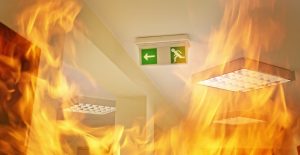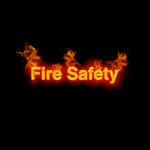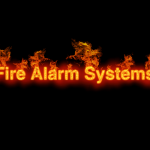Fire compartmentation is one of the best and most effective means of protecting lives and property from the hazards of fire. Unfortunately, it is also one of the most ignored means of ensuring a building has safe means of escape for occupants that companies have at their disposal.
Compartmentation provides the subdivision of the building’s internal spaces into small manageable areas that also negate the spread of smoke and fire to other parts of a building. Our experienced professional fire compartmentation surveyors are skilled in conducting both non-intrusive and, if need be, intrusive surveys.
Our main goal is to find out whether fire compartmentation in a building exists, its robustness and adequacy, and, crucially, its suitability in the context of your building. Our fire compartmentation survey service goes beyond the scope of a typical fire risk assessment. Importantly, we help you fulfil the provisions of the Fire Safety Order.
Contents
- 1 What Is Fire Compartmentation?
- 2 What Is a Fire Compartmentation Survey?
- 3 What Is Included in a Fire Compartmentation Survey?
- 4 What Are the Fire Compartmentation Building Regulations?
- 5 What Is the Difference Between a Fire Compartmentation Survey and a Fire Stopping Survey?
- 6 What Are Fire Compartmentation Drawings?
What Is Fire Compartmentation?
 A fire compartment is defined as part of a building made of one or more rooms, storeys, or spaces or a building that is designed and constructed to prevent the spread of fire to and/or from other parts of the same building or adjoining building. In the case of compartmentation of different parts of the same building, compartmentation walls and floors are used. The compartmentation walls should run the full height in one vertical plane.
A fire compartment is defined as part of a building made of one or more rooms, storeys, or spaces or a building that is designed and constructed to prevent the spread of fire to and/or from other parts of the same building or adjoining building. In the case of compartmentation of different parts of the same building, compartmentation walls and floors are used. The compartmentation walls should run the full height in one vertical plane.
As such, a fire compartment is a section of a building that is separated from other parts of a building by compartment walls and compartment floors constructed using fire-resistant materials. As such, compartmentation is the process of subdividing a building into a number of distinct fire compartments. In dividing a building into different sections, you prevent the spread of fire across the entire building.
Every building has should have its own bespoke compartmentation, taking into account:
- The fire load,
- The various uses in the building,
- The height of the structure, and
- The availability of fire suppression systems such as automatic sprinkler systems.
Fire compartmentations are effective at preventing the immediate spread of fire to other parts of the building. Compartmentation is equally effective at negating the chances of fire growing and make it impossible for the occupants, rescue services personnel, and other people in and around the building. On the property front, compartmentation is effective at reducing property damage on the building and the valuables inside the building.
What Is a Fire Compartmentation Survey?
While a fire risk assessment covers some aspects of the fire compartmentation, a fire compartmentation survey assesses everything in more detail. A fire compartmentation survey explores the compartmentation measures (for instance, the use of fire dampers) used in a building to determine their effectiveness. In some instances, samples are collected and studied. The goal is to determine whether the existing measures are suitable in the prevailing circumstances.
Our compartmentation surveys are comprehensive, covering everything from floors, walls, wall voids, roof, voids, basements, shafts, and risers. In the detailed survey report, we create, we indicate the status of your compartmentation measures.
Importantly, we make recommendations on areas you can make improvements to enhance the safety of all occupants and your property contained within the building. The improvements are also crucial as they ensure you operate your business premises in compliance with statutory requirements.
What Is Included in a Fire Compartmentation Survey?
 A fire compartmentation survey includes:
A fire compartmentation survey includes:
- An in-depth assessment of the compartmentation strategy deployed in the building
- A thorough inspection of all the fire compartmentation mechanisms used in the basements, walls, floors, roof, roof voids, floor voids, ceiling voids, shafts, and risers
- A survey of the current state of the compartmentation measures. We identify any defects in the compartmentation according to British Standards, Approved Document B as contained in the Building Regulations and/or any building-specific Fire Strategy
- An in-depth inspection of all the fire doors in the building
- A concise action plan that contains the location of the defects and shortcomings, photographic evidence, and the recommended remedial actions to fix the issues
- Comprehensive mark-ups of the current floor plans with a clear indication of the location of the fire compartmentation floors and walls, or
- We develop CAD plans from measured surveys of the compartmentation floors and walls
What Are the Fire Compartmentation Building Regulations?
Under the Building Regulations’ Approved Document B, the legislation necessitates the subdivision of buildings into compartments with the separation of the various compartments done by fire-resistant floor and/or walls.
The regulations require the compartments to generate a safe barrier between the compartments, thereby reducing the risk of fire and smoke spreading rapidly in a building. Importantly, the regulations are designed to provide occupants of a building ample means of escaping in the event a fire breaks out.
Our fire compartmentation surveys are designed to help you meet the requirements laid out in the regulation.
What Is the Difference Between a Fire Compartmentation Survey and a Fire Stopping Survey?
Fire compartmentation surveys and fire stopping surveys are closely related services. However, they are distinctly different, especially in the survey scope.
As the name suggests, a fire stopping survey relates to surveys done on the fire stopping measures taken and the systems deployed within a building. With this kind of survey, our fire engineering consultants identify the potential problem areas, especially with regards to the deterioration of fire-resistant walls and floors.
On the other hand, fire compartmentation surveys relate to the assessments done to find out whether a building meets the regulations laid out in British Standards, Approved Document B. As such, we provide companies with fire compartmentation surveys services to ensure their building have the right fire compartmentation in place.
What Are Fire Compartmentation Drawings?
Fire compartmentation drawings are plan drawings that detail the fire compartmentation, fire doors, the fire exit signage, the exit routes, the service isolation locations, the fire fighting equipment, and the alarm manual call locations.
The purpose of such drawings is to create a clear evacuation plan for the building. Additionally, the plans also serve as the safety training tools as it allows companies to train their staff on matters of fire safety. Finally, companies need Fire Compartment Drawings as part of making applications for proposed building works.




